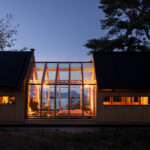Studies have shown that free play isn’t just good for children’s brain development — and that playground time may be even more beneficial than classroom instruction — but also that adults need play, too. From card games to recreational sports, play helps humans maintain social connections and keeps our brains sharp.
Mount Pavilia, a brand new low rise residential development located in Hong Kong’s lush Clearwater Bay and developed by New World Development’s The Artisanal Movement, is a pioneering project that heralds the artisanal lifestyle for the next generation.

Cultural Entrepreneur Adrian Cheng
Through the articulation of The Artisanal Movement, Cultural Entrepreneur Adrian Cheng is dedicated to collecting and sourcing the best creative talents from around the globe and bring them back to his projects for cross-cultural exchanges, be it an idea, aesthetic or concept. Mount Pavilia boasts beautiful greenery that sets a perfect backdrop of its own, and with such natural blessings, Cheng believed that the Amsterdam-based architecture, design and engineering firm Carve was the best pick to create a wonderful and adventurous playscape for children.
Carve is known for its untraditional children’s recreational facilities, from Amsterdam’s Beuningenplein Playground to inventive climbing structures at Singapore’s Gardens by the Bay, designed as the “living room” of the new community.

Carve’s Elger Blitz in front of Mount Pavilia’s Central Park play structure
For Mount Pavilia, Carve conceived five custom play spaces, including a Toddler Area, Central Park, Multi-Intelligence Indoor Play Area, Water Play Zone and Urban Farm. Each of these spaces helps children unleash their imaginations with minimalist designs that have few functional restrictions.
This allows children of all ages to socialize, communicate, and create worlds of their own making. “Instead of making use of archetypical playground-equipment, tending to be pretty directive on what to do and how to play, we prefer to work with more general objects, playable landscapes or multi-usable interventions,” explained Carve’s senior designer Elger Blitz.


Material details from Mountain Pavilia’s Central Park
Mount Pavilia’s Central Park is specially designed with semi-open cylinders catering kids in different ages, allowing children to feel like they belong in their own little world while maintaining high transparency for parents. Meanwhile, the open layout makes it easy for children to mingle with other play companions. Rather than make the structure a splashy color, as is typical, Carve kept the palette white and minimal, allowing it to act as a blank canvas for playful activity.

Mount Pavilia’s Indoor Multi-Intelligence Play Area
The design of the Indoor Multi-Intelligence Play Area is based on the “theory of multiple intelligences,” developed by Harvard professor Howard Gardner. The area also includes a library, reading area, large building blocks, a two-story dollhouse, giant slides, and other features to nurture and inspire each of the eight abilities related to multiple intelligences.
The family-friendly Urban Farm engages adults and children in sustainable practices. Planting gardens and an education area allow children and parents to plant crops together and experience nature’s ecosystems first hand. Families can then cook and prepare what they grow in the outdoor dining and barbecue area. (In addition, there are more than 1,000 trees of 30 varieties planted around Mount Pavilia, along with a butterfly garden to encourage biodiversity.)
The Water Play Zone, meanwhile, appears at first glance as a striking contemporary sculpture, its minimalist pool of shallow water lined with shimmering tiles and punctuated with stone plinths that incorporate a series of fountains.

Mount Pavilia’s Water Play Zone
“We consider playgrounds as an integral part of public space,” said Elger Blitz. “We strive for playgrounds to be inviting places that to be discovered. They should be challenging and safe at the same time.” For the play areas at Mount Pavilia, Carve thought about how each space could accommodate as many functions and users of different ages as possible. “A skate-course can indeed make a marvelous track for four-year-olds on their bikes on a Sunday morning,” suggested Blitz.
At Mount Pavilia, the play spaces aren’t just a nice amenity. As Blitz explains, kids attract other kids, as well as their parents, caregivers, and educators. Play spaces become meetings places and great conveners, creating integrated communities. “All communities need spaces where people come together,” argues Blitz.
A 680-unit development in its entirety, Mount Pavilia encompasses 21 towers and six residential blocks all centered around idyllic green spaces, four specially-commissioned sculptures and a combined clubhouse and gallery called The White Yard, designed by celebrated Korean architect Minsuk Cho. Carve’s work at the heart of this development enriches the common spaces for both children and adults, making it a veritable paradise for families.









